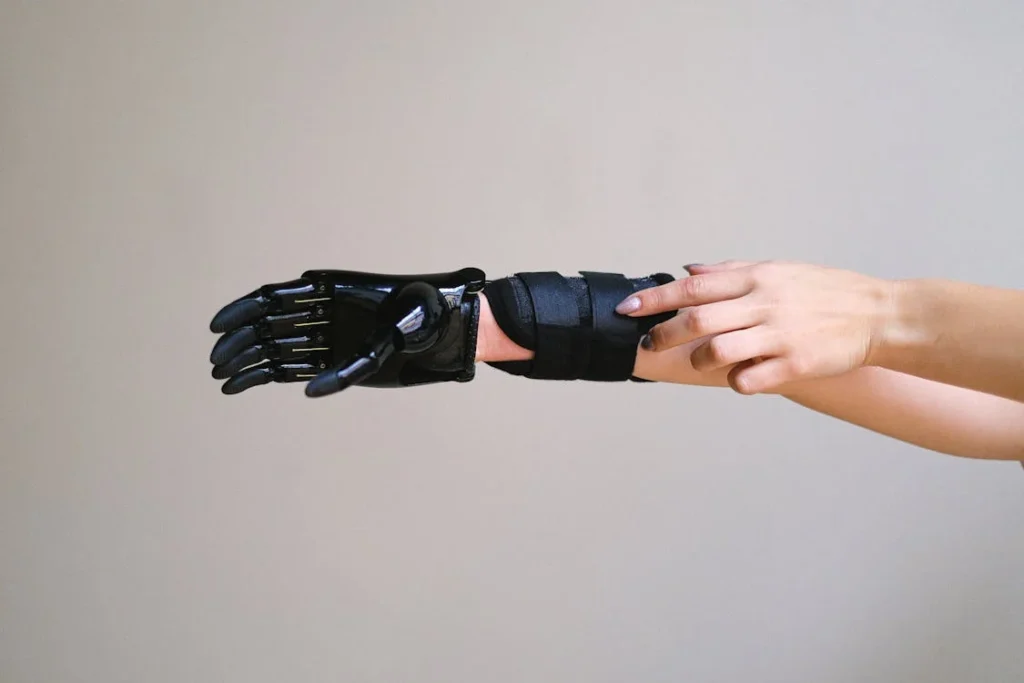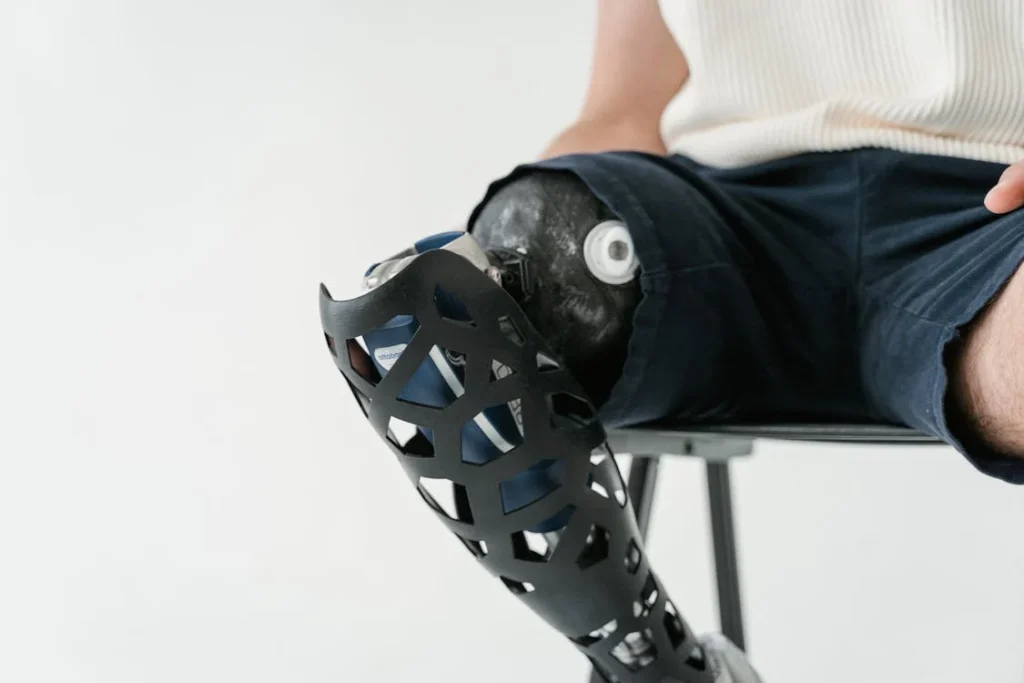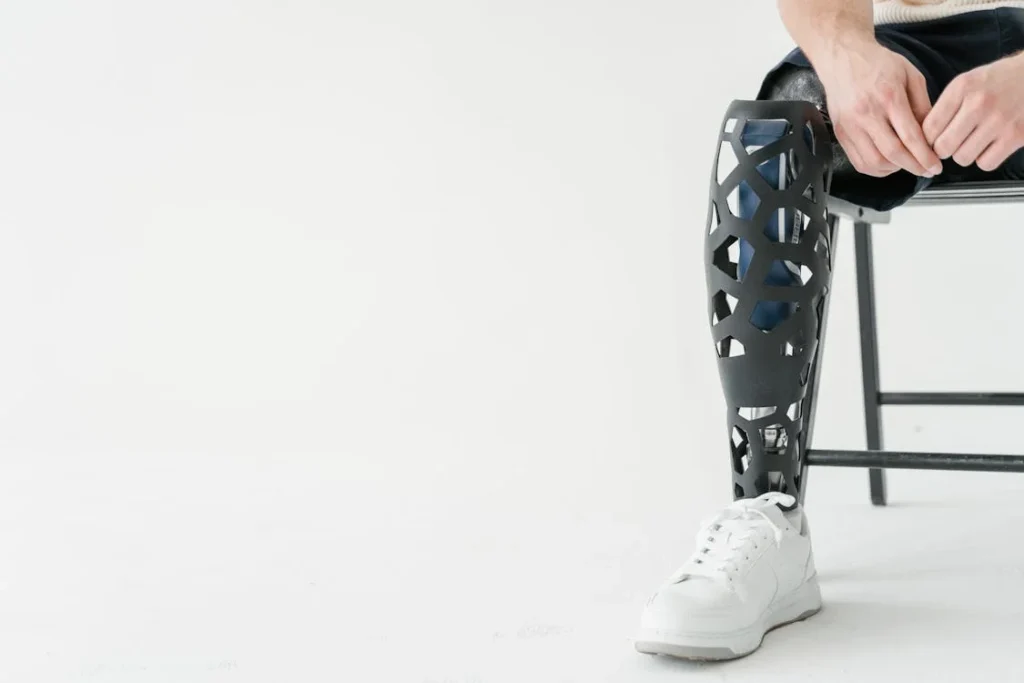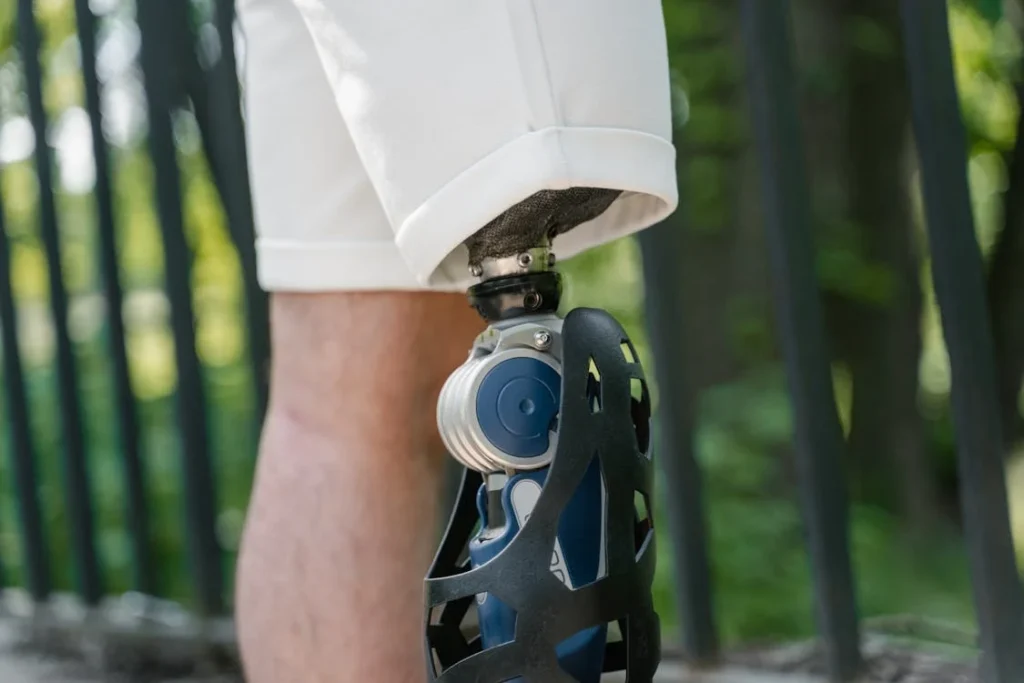A prosthetic limb is more than just a tool; it’s a part of your daily life, helping you move, work, and engage with the world. Over time, however, even the best prosthetics may no longer meet your needs. Whether it’s due to wear and tear, advances in technology, or changes in your body, there comes a time when upgrading or replacing your prosthetic limb becomes essential.
But how do you know when it’s time to make that decision? In this article, we’ll guide you through the key signs and considerations to help you determine the right moment for an upgrade or replacement, ensuring your prosthetic continues to support your independence and well-being.

Understanding the Lifespan of a Prosthetic Limb
Prosthetic limbs are designed to be durable, but they are not indestructible. Their lifespan depends on several factors, including the materials used, the type of prosthetic, and how often it is used.
For instance, an active individual may need a replacement sooner than someone with a more sedentary lifestyle. On average, prosthetic limbs last between three to five years, though some may require adjustments or component replacements during that time.
Why Lifespan Varies
The variability in a prosthetic limb’s lifespan often comes down to the user’s activity level and environmental exposure. High-impact activities like running or sports can put additional strain on the device, leading to faster wear and tear.
Similarly, exposure to water, dust, or extreme temperatures can affect materials, particularly in components like liners, straps, or joints. Regular maintenance can help extend the prosthetic’s life, but even with the best care, eventual replacement is inevitable.
Factors That Affect a Prosthetic’s Lifespan
Every prosthetic limb is subjected to unique conditions that impact its longevity. One of the primary factors is the type of prosthetic and its intended use.
Devices designed for high-impact activities, such as running or sports, typically experience more strain, which can shorten their usable life. Conversely, prosthetics used for everyday tasks may last longer due to lower levels of stress on components.
Material quality is another significant factor. Prosthetics made from advanced materials, such as carbon fiber or titanium, tend to be more durable and resistant to environmental factors.
However, even the strongest materials are not immune to gradual fatigue, especially in moving parts like hinges or joints.
Environmental conditions also play a role. Exposure to moisture, dust, extreme temperatures, or corrosive substances can degrade materials over time, particularly in parts like straps, liners, or electronic components.
Users who frequently encounter challenging environments may need to replace their prosthetic sooner.
Balancing Durability with Daily Use
Prosthetics are engineered to strike a balance between durability and functionality. For example, a lightweight prosthetic designed for comfort and mobility may not be as rugged as one built for heavy-duty tasks.
Users must consider their lifestyle when evaluating how long their prosthetic is likely to last.
For instance, an individual using a lower-limb prosthetic for daily walking may find it lasts several years with proper care, while someone engaged in physical labor might notice faster wear and tear.
Similarly, a bionic prosthetic with complex electronics may require more frequent servicing to maintain its advanced features compared to a simpler mechanical design.
The Role of Regular Maintenance
Regular maintenance is critical for extending the lifespan of a prosthetic limb. Inspections and tune-ups help identify early signs of wear or misalignment, preventing small issues from developing into major problems.
Routine cleaning and lubrication can also protect materials and moving parts, ensuring the device functions smoothly for as long as possible.
A well-maintained prosthetic not only lasts longer but also performs consistently, offering users peace of mind and reliability in their daily lives. Conversely, neglecting maintenance can lead to faster degradation and unexpected failures, reducing the prosthetic’s usable life.
Knowing When to Replace
Even with diligent care, all prosthetics eventually reach the end of their lifespan. It’s important for users to recognize the signs that indicate a prosthetic is no longer meeting their needs. These may include visible damage, frequent malfunctions, or persistent discomfort.
In some cases, a prosthetic might still function but fail to align with the user’s changing lifestyle or goals.
For example, advancements in prosthetic technology could offer features that significantly enhance mobility, making an upgrade worthwhile even if the current device is still operational.
Planning for Longevity
Understanding the lifespan of a prosthetic limb helps users plan for replacements or upgrades without unexpected disruptions.
By monitoring the condition of the prosthetic, adhering to maintenance schedules, and consulting with a prosthetist regularly, users can ensure their device remains a reliable part of their daily life.
Ultimately, the lifespan of a prosthetic limb is not just about how long it lasts but how well it continues to support the user’s independence and mobility.
Making informed decisions about care and replacement ensures the prosthetic serves its purpose effectively, every step of the way.

Signs It May Be Time for an Upgrade or Replacement
While regular maintenance and inspections can keep your prosthetic functioning well for years, certain signs indicate it’s time to consider an upgrade or replacement. Being proactive can prevent discomfort, injuries, and disruptions to your daily routine.
1. Decreased Comfort or Fit
Over time, your body changes, and so does the fit of your prosthetic. Weight fluctuations, muscle atrophy, or swelling can alter how the prosthetic feels.
If you experience persistent discomfort, pressure points, or skin irritation, it’s a clear sign the socket or liner may no longer fit properly. Adjustments can sometimes resolve these issues, but in other cases, a full replacement may be necessary to restore comfort.
2. Reduced Functionality
A prosthetic limb should work seamlessly with your body, supporting your movements without hindrance. If you notice reduced functionality, such as difficulty with movement or issues with stability, it could indicate wear and tear in the components.
For bionic prosthetics, diminished responsiveness in sensors or motors might also signal the need for a replacement.
3. Frequent Repairs or Malfunctions
If your prosthetic requires frequent repairs or exhibits recurring issues, it may no longer be cost-effective to maintain.
Components such as joints, hinges, or bionic sensors can degrade over time, and constant repairs might indicate that the device is reaching the end of its useful life. Replacing the prosthetic with a newer, more reliable model can save time, money, and frustration in the long run.
4. Outdated Technology
Advances in prosthetic technology happen rapidly. Features that were state-of-the-art a few years ago might now be outdated.
Modern prosthetics, such as Grippy™, offer improved functionality, lighter materials, and enhanced control, often integrating features like touch sensitivity or smartphone connectivity.
If your current prosthetic lacks the capabilities you need to maintain an active and fulfilling lifestyle, upgrading to a newer model might be the right choice.
5. Lifestyle Changes
Life changes, and so do your needs. Perhaps you’ve taken up a new sport, started a physically demanding job, or need better support for increased mobility.
Your prosthetic should evolve with you. If your current device isn’t keeping up with your activities or new goals, an upgrade tailored to your lifestyle can make a significant difference in your comfort and performance.

Key Considerations Before Making the Decision
Deciding to upgrade or replace your prosthetic limb is a significant step. To ensure you make the best choice, there are several factors to evaluate, from your daily needs to the potential benefits of new technology.
Assessing Your Needs
The first step is understanding what you need from your prosthetic. Reflect on your daily routine, physical activities, and any challenges you face with your current device.
Are you looking for better comfort, improved functionality, or a device that supports a more active lifestyle? A clear understanding of your priorities will guide you in selecting the right replacement or upgrade.
Consulting with Your Prosthetist
Your prosthetist is an invaluable partner in this process. They can assess the condition of your current prosthetic, evaluate changes in your body, and recommend options that align with your needs and budget.
Prosthetists can also explain the features of newer models and how they might enhance your quality of life.
Budget and Insurance
Replacing or upgrading a prosthetic limb can be a financial investment. Check your insurance coverage to understand what costs may be reimbursed.
Many insurance plans cover prosthetic replacements at regular intervals, typically every three to five years. If you’re concerned about costs, speak with your prosthetic provider about payment plans or financing options.
Timing the Upgrade
It’s important to choose the right time for an upgrade. Waiting too long could lead to discomfort or reduced mobility, but replacing a prosthetic too soon might feel premature.
Monitoring the signs of wear and consulting with your prosthetist regularly can help you strike the right balance.

The Advantages of Upgrading to New Technology
Prosthetic technology is advancing rapidly, offering users opportunities to significantly enhance their mobility, comfort, and quality of life.
Upgrading to a newer prosthetic model isn’t just about replacing an old device—it’s about embracing innovation that can unlock new possibilities.
By understanding the benefits of modern prosthetic technology, users can make informed decisions that improve their daily experience and long-term well-being.
Unlocking Greater Functionality
Modern prosthetic limbs incorporate features that provide improved precision, responsiveness, and adaptability.
For instance, bionic devices now include advanced sensors that can detect and respond to subtle muscle movements, enabling more natural and intuitive control.
This is particularly beneficial for tasks requiring fine motor skills, such as gripping small objects or performing detailed manual work.
For lower-limb prosthetics, advancements in microprocessor-controlled knees and ankles provide enhanced stability and support, particularly on uneven terrain or stairs.
These features reduce the effort required to move, allowing users to focus less on managing their prosthetic and more on their activities.
Embracing Lightweight and Durable Materials
Older prosthetics, while functional, often relied on heavier materials that could contribute to fatigue during extended use. Upgraded prosthetics use cutting-edge materials like carbon fiber and titanium, which offer a superior balance of strength and weight.
These materials not only make the device easier to wear for long periods but also improve its durability, ensuring it can withstand the rigors of daily life without frequent repairs.
Enhancing Aesthetics and Personalization
Prosthetic technology has evolved to offer a higher degree of customization and aesthetic appeal. Modern devices can be tailored to match the user’s preferences, whether it’s through more natural-looking finishes or sleek, futuristic designs.
This level of personalization empowers users to feel more confident and comfortable, viewing their prosthetic as an extension of themselves rather than a medical device.
Additionally, some prosthetics now incorporate user-specific adjustments, allowing them to adapt to individual needs or activities.
For example, a runner might benefit from a specialized limb designed for high-impact activity, while someone with a desk job might prioritize comfort and flexibility.
Advanced Connectivity and Integration
The integration of smart technology into prosthetics has transformed how users interact with their devices.
Many modern prosthetics, like Grippy™, come equipped with smartphone apps or wireless connectivity, enabling users to customize settings, monitor performance, and receive software updates.
This connectivity provides a higher degree of control, allowing users to fine-tune their prosthetic to match their activities or preferences. For example, a user might adjust the grip strength of a bionic hand for different tasks or switch between modes for walking and running.
These features not only enhance usability but also create a more dynamic and interactive experience.
Improving Energy Efficiency
Energy efficiency is a key consideration in modern prosthetic design, particularly for bionic limbs that rely on battery power. Newer devices feature longer-lasting batteries and energy-saving mechanisms that extend the time between charges.
This reduces the inconvenience of frequent recharging and ensures the prosthetic is ready to support the user throughout the day.
For users of mechanical prosthetics, advancements in energy transfer mechanisms allow for smoother and more efficient motion. These improvements reduce the physical effort required to operate the prosthetic, minimizing fatigue and increasing endurance.
Reducing Maintenance Needs
Upgrading to a newer prosthetic can also reduce the need for ongoing maintenance. Modern devices are engineered with improved durability and reliability, meaning fewer repairs and replacements are required over their lifespan.
For users who have experienced frequent breakdowns or malfunctions with older models, this can be a game-changer, providing peace of mind and saving both time and money.
Addressing Lifestyle Changes
As users’ lives evolve, their prosthetic needs may change as well. An upgrade allows users to align their device with their current lifestyle, whether that involves taking up a new sport, pursuing a physically demanding job, or simply enjoying a more active daily routine.
Modern prosthetics are designed with versatility in mind, making them adaptable to a wide range of activities and environments.
Transforming Rehabilitation and Adaptation
Many advanced prosthetics now come with integrated tools and programs that support rehabilitation and adaptation. For example, gamified rehabilitation systems can help users develop better control and coordination with their new device in a fun and engaging way.
These features not only shorten the learning curve but also improve the user’s confidence and skill with their prosthetic.

Emotional and Psychological Benefits of Upgrading
Upgrading or replacing a prosthetic limb isn’t just a physical improvement—it’s an emotional and psychological boost as well. A prosthetic that meets your needs can significantly impact your mental well-being, giving you greater confidence and a sense of empowerment.
Renewed Confidence
Using a prosthetic that fits well and functions effectively allows you to move without hesitation, whether you’re walking into a crowded room or participating in a physical activity.
Knowing that your device is reliable and up to date can boost self-esteem, helping you approach new opportunities with confidence.
Reclaiming Independence
A malfunctioning or outdated prosthetic can make even simple tasks frustrating. Upgrading to a new device eliminates these barriers, enabling you to regain full control of your daily life.
Whether it’s cooking, working, or playing with your children, a dependable prosthetic restores independence, reducing the need for external assistance.
Feeling Connected to Innovation
Switching to a newer prosthetic often introduces you to exciting features and technologies. Adopting these advancements can make you feel more connected to the modern world, enhancing your sense of agency and optimism about the future.
The ability to interact with innovative tools, such as prosthetics with artificial intelligence or advanced touch sensitivity, can be transformative.
When Replacing a Prosthetic Can’t Wait

While prosthetic replacement can often be planned, there are situations where waiting is not an option. Delaying action in these cases can lead to discomfort, safety risks, or a decline in your quality of life.
Knowing when a replacement is urgently needed helps you stay proactive and avoid complications that could impact your mobility or health.
Immediate Safety Concerns
A prosthetic limb must provide stability and support at all times. If structural damage compromises its ability to function safely, replacement should take priority.
Cracks in the socket, fractures in joints, or loose components can weaken the prosthetic’s integrity, increasing the risk of falls or other accidents.
Even a minor malfunction in a bionic prosthetic, such as unresponsive sensors or faulty motors, can create dangerous situations, particularly during activities that require precision or balance.
Ignoring these issues can lead to serious injuries, both from accidents and from the strain placed on your body when compensating for a failing device. A timely replacement ensures your safety and allows you to move confidently.
Persistent Pain and Discomfort
Comfort is a cornerstone of prosthetic functionality. When your prosthetic causes constant discomfort, pain, or skin issues, it’s a clear sign that immediate action is needed.
Persistent pressure sores, blisters, or irritation can develop into more severe conditions if left unaddressed. Over time, such issues may limit your ability to wear the prosthetic altogether, reducing your independence and mobility.
In cases where adjustments or minor repairs fail to resolve the discomfort, replacing the prosthetic may be the only solution. A new device with a better fit can eliminate pain and allow you to focus on living life without unnecessary distractions.
Significant Functional Limitations
A prosthetic limb is meant to enhance your ability to perform daily tasks and pursue your goals. When it becomes a barrier instead of a support, immediate replacement is often necessary.
Functional limitations, such as difficulty walking, reduced grip strength, or restricted range of motion, can make it challenging to perform even simple activities.
This is especially critical for individuals with active lifestyles or demanding routines. Whether it’s maintaining balance during physical labor or using fine motor skills for detailed tasks, a prosthetic that no longer meets functional needs can hinder progress and productivity.
Replacing the prosthetic restores its role as an empowering tool, helping you regain control of your daily life.
Rapid Physical Changes
Your body is dynamic, and factors like weight loss, weight gain, or muscle atrophy can affect how well your prosthetic fits. These changes may occur gradually or suddenly due to medical conditions, surgeries, or lifestyle shifts.
When a prosthetic no longer accommodates your body’s shape or size, it can lead to discomfort, instability, and reduced performance.
In such cases, adjustments may provide a temporary solution, but a full replacement is often required to ensure proper alignment and support.
Addressing these changes promptly with a new prosthetic can prevent secondary issues, such as joint strain or altered posture, that may arise from continued use of an ill-fitting device.
Environmental or Situational Demands
Sometimes, external circumstances demand an immediate upgrade or replacement of a prosthetic. For instance, if you are transitioning to a more physically demanding job, taking up a new sport, or preparing for a significant life event, your current prosthetic may no longer suffice.
Similarly, users moving to environments with extreme weather conditions, such as high humidity or freezing temperatures, may need a prosthetic designed to withstand these challenges.
In such scenarios, a replacement ensures you are equipped with a device that can handle your evolving needs and circumstances without compromising performance or durability.
Avoiding Long-Term Consequences
Delaying a necessary prosthetic replacement can have long-term consequences, both physically and emotionally. Overcompensating for a failing prosthetic can lead to muscle fatigue, joint pain, or alignment issues, which may require extensive treatment to correct.
Additionally, the frustration of using a malfunctioning or uncomfortable device can take a toll on mental well-being, leading to stress or a diminished sense of independence.
By replacing the prosthetic as soon as problems arise, you can avoid these complications and ensure that your device continues to support your health and happiness.

Steps to Take When Planning an Upgrade
Replacing your prosthetic limb is a significant milestone, and taking a strategic approach ensures you get the most out of the transition. Thoughtful planning not only makes the process smoother but also ensures your new device aligns perfectly with your goals and lifestyle.
Research Your Options
Start by exploring the latest prosthetic technologies and models. Consider what features are most important to you—whether it’s improved durability, advanced bionic controls, or better aesthetics.
Look for manufacturers like Robobionics, which offer cutting-edge prosthetics that are lightweight, ergonomic, and feature-rich.
Schedule a Consultation
Meeting with your prosthetist is a crucial step in the process. They will assess your current prosthetic, discuss your needs, and recommend devices that suit your lifestyle. A consultation also provides an opportunity to test new models and get a sense of how they feel and function.
Consider Rehabilitation
Adapting to a new prosthetic often requires a period of adjustment. Gamified rehabilitation programs, such as those offered by Robobionics, can make this process engaging and intuitive.
These programs help you develop familiarity with your new prosthetic while building strength and coordination.
Evaluate the Long-Term Benefits
Think about how the new prosthetic will improve your daily life. Consider not only immediate improvements in comfort and functionality but also how the upgrade will support your long-term goals.
A well-chosen prosthetic can unlock new opportunities, enabling you to achieve more in your personal and professional life.
Conclusion
Upgrading or replacing your prosthetic limb is a pivotal decision that can transform your mobility, comfort, and overall quality of life. While it might seem daunting at first, recognizing the signs—such as discomfort, reduced functionality, or the need for better technology—can guide you toward a solution that truly meets your needs.
At Robobionics, we’re here to support you every step of the way, from understanding your options to ensuring a seamless transition to your new prosthetic. If you think it might be time for a change, we invite you to connect with our team and explore how our innovative solutions can enhance your journey.
Ready to take the next step? Book a free consultation with Robobionics today and discover the possibilities. Get Started



